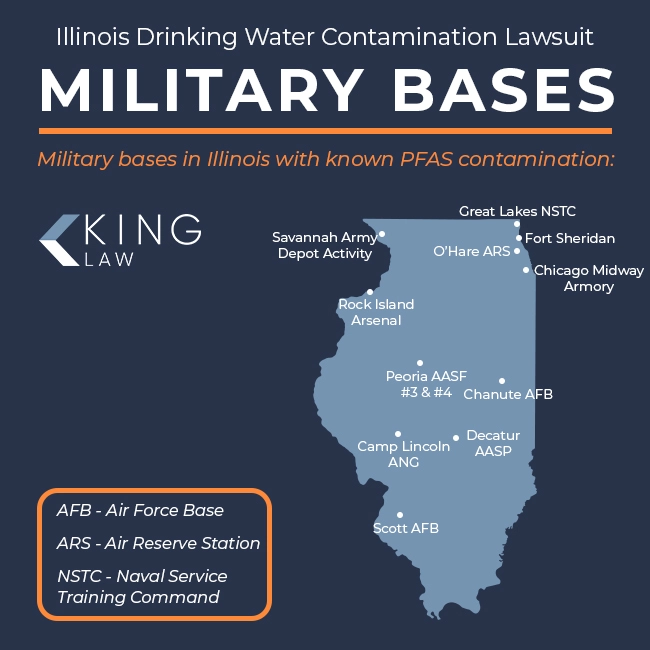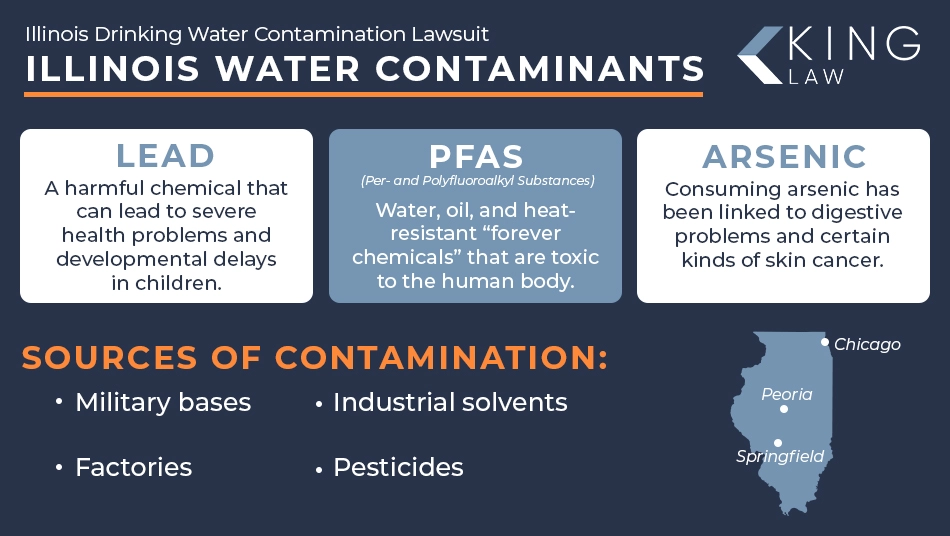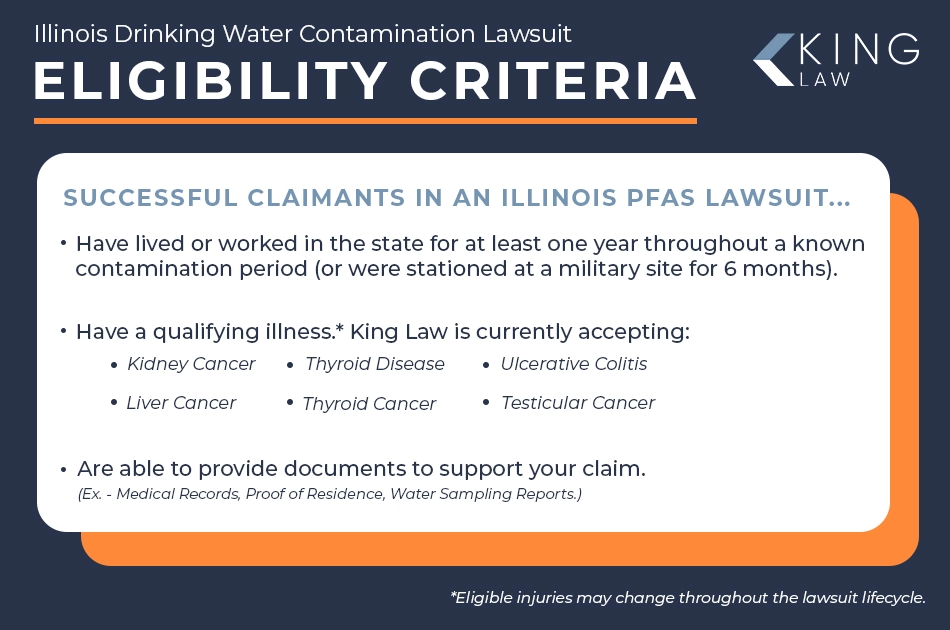
While Illinois is known for the “Windy City,” presidents, and famed sports teams, it is also home to contaminated water sources. The Environmental Protection Agency recently announced that over 47 water systems in “The Prairie State” are contaminated with forever chemicals (PFAS) that are dangerous to humans and the environment. Hundreds of thousands of people in Illinois have PFAS in their drinking water. These chemicals have been linked to severe adverse health conditions, including kidney cancer, testicular cancer, thyroid cancer, liver cancer, thyroid disease, and ulcerative colitis.
Contamination of Illinois groundwater in many communities, such as Lincoln, Peoria, North Park, and Rockton, is believed to be the result of run-off from commonly used fire-fighting foams and industrial solvents, as well as other sources. Individuals who were diagnosed with an illness related to consuming contaminated water in Illinois are encouraged to seek legal counsel. Depending on the circumstances, affected individuals may be awarded compensation through a lawsuit.
About the Illinois Water Contamination Lawsuit
Illinois Water Contamination Lawsuit Overview
Timeline of Water Contamination in Illinois | 2025 Update
Sources of Water Contamination in Illinois
Illinois’s Regulations for Drinking Water
Contaminants Found in Illinois Drinking Water
Current Water Quality in Illinois
Health Risks and Symptoms Linked to Drinking Water in Illinois
Eligibility Criteria for the Illinois Water Contamination Lawsuit
Illinois Water Contamination Settlement and Payout Amounts
How to File an Illinois Water Contamination Lawsuit
Statute of Limitations for Illinois Water Contamination Claims
Illinois Water Contamination Lawsuit Overview
It is estimated that more than 400,000 Illinois residents drink water contaminated with PFAS or “forever chemicals” and other toxins. Communities from throughout the state, including Bethalto and Edwardsville, have been notified that their water systems have been contaminated with PFAS.
It is widely accepted that the contamination was the result of runoff from products containing PFAS, such as aqueous film-forming foam (AFFF). The foam was used for decades at military bases across the country, including at Scott Air Force Base, located in St. Clair County, and Chanute Air Force Base, located in Rantoul.
Exposure to dangerous chemicals, including PFAS, can cause serious health conditions. Studies show that when PFAS are allowed to build up in the body, they may lead to an increased risk of certain kinds of cancer, thyroid disease, ulcerative colitis, and other conditions. Individuals who have been diagnosed with one of these conditions after consuming contaminated water in Illinois may be eligible for compensation and are encouraged to seek legal counsel as soon as possible.
Timeline of Water Contamination in Illinois | 2025 Update
July 20, 2025: Cresthill Community Battles PFAS Contamination
After receiving a notice from the Illinois EPA, the Cresthill area is still battling PFAS contamination in its water supply. The community is located southwest of Chicago. According to the notice, water supplies in the area have high levels of perfluorooctanoic acid (PFOA) and perfluorohexanesulfonic acid (PFHxS). Water suppliers in the area plan to have the water purified by 2030 and are investigating new technologies to remove PFAS from water supplies.
July 14, 2025: Peoria Water District Issues Notice About High Levels of Lead in Water Supply
Illinois American Water, which supplies water to the Peoria area, issued a notice to customers after several samples showed elevated levels of lead in drinking water. The elevated samples were collected from the Peoria District water system between January and June of 2025. The utility has said it has contacted customers where lead-laden samples were collected.
May 14, 2025: EPA Announces Regulatory Flexibility When It Comes to PFAS
The EPA has announced that it will keep National Primary Drinking Water Regulations (NPDWR) at their current levels and will extend PFAS compliance dates to 2031, delaying implementation for at least two years. The extension allows cities, towns, and states with contaminated drinking water systems, including Illinois, time to develop and implement solutions to address the level of PFAS.
April 28, 2025: EPA Announces New Actions to Combat PFAS in Drinking Water
U.S. Environmental Protection Agency (EPA) Administrator Lee Zeldin announced new actions to address PFAS in drinking water. The announcement comes after the Trump Administration signaled that the EPA would be rolling back previously planned regulatory actions to further limit the actionable PFAS levels in drinking water. Without strict guidance from federal agencies, states like Illinois are left to establish their own rules and regulations when it comes to PFAS levels.
April 15, 2025: Illinois EPA Sends PFAS Alert to State Residents
The Illinois EPA issued a notice affecting more than 400,000 residents that warned about the elevated levels of PFAS in their water supplies. More than 47 water suppliers in the state were found to have PFAS levels exceeding federal standards.
April 11, 2025: Illinois Pollution Control Board Published Amendments to Groundwater Quality in the Illinois Register
The Illinois Pollution Control Board published amendments to the Illinois Administrative Code, including setting groundwater quality standards for six PFAS. The new standards align with federal guidelines issued by the Environmental Protection Agency.
March 5, 2025: New Bill Requires Illinois Pollution Control Board to Adopt Rules to Establish Maximum Contaminant Levels for PFAS
On March 5, 2025, Governor Pritzker signed Public Act 103-1077 into law, requiring the Illinois Pollution Control Board to adopt rules establishing maximum contaminant levels (MCLs) for PFAS. According to the bill, the MCLs must be “identical in substance” to MCLs established by the U.S. Environmental Protection Agency.
September 16, 2024: IEPA Announces Health Advisory for Perfluorobutanoic Acid (PFBA)
The Illinois Environmental Protection Agency (IEPA) issued a health advisory for perfluorobutanoic acid (PFBA), a compound in the per- and polyfluoroalkyl substances (PFAS) family of chemicals, after the toxin was detected in groundwater in the state. The new guidance level is 0.007 milligrams per liter.
January 1, 2022: PFAS Reduction Act Takes Effect in Illinois
The PFAS Reduction Act took effect on January 1, 2022. The Act regulates the use of Class-B firefighting foam, also known as aqueous film-forming foam (AFFF), in Illinois. AFFF is known to contain PFAS and has caused adverse health effects in firefighters and military service members in Illinois and across the country. Individuals have filed military base water contamination lawsuits alleging manufacturers of AFFF knew the product was dangerous but failed to warn consumers about the potential for harm.
September 14, 2020: Illinois EPA Announces Plans to Test All Community Water Supplies for PFAS
The Illinois EPA announced it will begin testing community water supplies statewide to determine levels of PFAS. The state regulatory agency determined it would take between 12 and 15 months to complete testing on all 1,749 community water supplies in the state. At the conclusion of testing, at least 81 sites had PFAS levels above minimum reporting limits and 68 above health-based guidance levels.
Sources of Water Contamination in Illinois
There are several potential sources of water contamination throughout Illinois. Toxic chemicals can seep into water supplies from factories, industrial solvents, pesticide use, household products, and other sources. Common sources of water contamination in Illinois include lead and PFAS. One of the most studied sources for PFAS contamination is run-off from firefighting foam used at military bases and airports throughout Illinois and across the country.
According to the Illinois Department of Public Health, PFAS are human-made chemicals, frequently used because they are waterproof and stain-resistant. PFAS frequently contaminate water sources near sites where PFAS-containing products are manufactured or used.
Products containing PFAS include:
- Carpets
- Clothing
- Food packaging
- Firefighting foam (aqueous film-forming foam [AFFF])
- Industrial applications
Places like Fox River, the Macon County Landfill, and the Naval Station Great Lakes all have substantial levels of PFAS that were detected in water sources or the surrounding environment. Individuals throughout Illinois may be at risk of exposure to contaminated water and should consider contacting an attorney if adverse health effects occur, including the development of testicular cancer, kidney cancer, thyroid cancer, or liver cancer.
Water Contamination From Military Installations
Individuals living or working on military bases in Illinois are at a heightened risk of toxic water exposure due to the use of fire-fighting foam that contains PFAS. Research indicates that runoff from the foam may seep into the ground, contaminating soil and groundwater supplies to the base and surrounding areas.
Military bases in Illinois with known PFAS contamination:
- Great Lakes Naval Service Training Command (2021-2022): 9,780 ppt for PFOS
- Fort Sheridan (2023): 3,900 ppt for PFHxS
- O’Hare Air Reserve Station (2018-2020): 13,800 ppt for PFOS + PFOA
- Chicago Midway Armory (2022): 47 ppt for PFOS
- Chanute Air Force Base (2018): 644,000 ppt for PFOS + PFOA
- Decatur AASP (2021): 87 ppt for PFOS
- Scott Air Force Base (2019): 104,000 ppt for PFOS + PFOA
- St. Louis Lambert International Airport (2019): 910 ppt for PFOS + PFOA
Water contamination at military bases throughout the United States have led to lawsuits against PFAS manufacturers and other entities.

Illinois’s Regulations for Drinking Water
Illinois has adopted enforceable standards for six PFAS that are known to exist in the state’s drinking water. These standards align with the federal standards released by the U.S. Environmental Protection Agency.
Types of PFAS with Enforceable Standards in Illinois:
- Hexafluoropropylene oxide dimer acid (GenX) HFPO-DA: 10 parts per trillion (ppt)
- Perfluorobutanesulfonic acid (PFBS): 2,000 ppt
- Perfluorohexanesulfonic acid (PFHxS): 10 ppt
- Perfluorononanoic acid (PFNA): 10 ppt
- Perfluorooctanoic acid (PFOA): 4 ppt
- Perfluorooctanesulfonic acid (PFOS): 4 ppt
Contaminants Found in Illinois Drinking Water
PFAS are considered “forever chemicals” since they do not break down easily in the environment. They are heat and water-resistant and build up in the body when consumed. While PFAS encompasses a large number of toxic chemicals, six have been identified and frequently studied, including PFOA, PFOS, HFPO-DA (“GenX” Chemicals), PFNA, and PFHxS. In addition to PFAS, the Illinois Department of Public Health has detected the presence of lead in water sources throughout the state. Exposure to lead can cause problems with the nervous system and developmental delays in children.
Per- and Polyfluoroalkyl Substances (PFAS)
Per- and polyfluoroalkyl substances, or PFAS, are dangerous synthetic chemicals that can be found in a number of different products. They have been deemed “forever chemicals” because they do not easily break down and are resistant to heat, water, oil, and gas. These toxins can build up in the human body and cause serious health concerns.
One of the most concerning sources of PFAS contamination is runoff from a firefighting foam, known as AFFF, which has resulted in thousands of lawsuits against manufacturers. The foam was used for decades by the U.S. military and aviation professionals. Despite knowing it contained dangerous toxins, the foam was used for training purposes and to extinguish fires for years, putting servicemembers, workers, and area residents at risk. Groundwater near military bases and airports often contains high levels of these toxic chemicals.
PFAS water contamination is a concern throughout the state of Illinois. Unsafe levels of these chemicals in drinking water are linked to:
- Birth defects
- Bladder cancer
- Breast cancer
- Changes in liver enzymes
- Decreased vaccine effectiveness
- Hodgkin’s and non-Hodgkin’s lymphoma
- Leukemia
- Lowered immune response
- Multiple-myeloma
- Kidney cancer
- Liver cancer
- Pancreatic cancer
- Prostate cancer
- Reproductive issues
- Testicular cancer
- Thyroid cancer
- Thyroid disease
- Ulcerative colitis
Lead
While the use of lead was banned in pipes in 1987, many homes throughout Illinois still contain plumbing lines with the dangerous element. State regulatory agencies, such as the Illinois Department of Public Health, have detected high levels of lead in aging properties throughout the state. As the pipes deteriorate over time, the potential for lead contamination increases, exposing both adults and children to the harmful chemical.
Lead exposure has been linked with several serious health problems, particularly in children. Even a small dose of lead can cause developmental delays, damage to the nervous system, and impaired hearing in children. In many cases, injuries resulting from lead exposure are permanent. The Illinois Department of Health recommends that residents test their water for lead levels, use cold water, and use a properly fitting filter.
Arsenic
The Illinois Department of Public Health has determined that elevated levels of arsenic have been found in some water sources throughout the state. Consuming water with high levels of arsenic can be detrimental to your health. Arsenic exposure has been linked to digestive problems and certain kinds of skin cancer. Water is generally contaminated with the toxic element as a result of mineral deposits and contact with hazardous waste, such as runoff from pesticides.

Current Water Quality in Illinois
Water quality in the state of Illinois varies by location and water supplier. Many water supplies in the state have been contaminated, and some of those contaminant levels are above state and federal thresholds.
However, the state government has taken some steps to address this issue. In addition to taking steps to set MCLs for PFAS in line with federal guidelines, Illinois lawmakers introduced the PFAS Reduction Act, which prohibits the use of Class B firefighting foams for training and testing in most circumstances. It also requires that the Illinois Emergency Management Agency be notified within 48 hours of the release or discharge of Class B firefighting foam.
Illinois residents can go to Drinking Water Watch, provided by the Environmental Protection Agency, for information on the quality of water in community water supplies.
Health Risks and Symptoms Linked to Drinking Water in Illinois
Studies show that drinking water contaminated with PFAS and other toxins has been linked with numerous health issues, including an increased risk of certain kinds of cancer. Research published in Environmental Toxicology and Chemistry found that exposure to PFAS can lead to several devastating conditions.
Health concerns linked to PFAS exposure:
- Altered immune function
- Thyroid dysfunction
- Liver disease
- Lipid dysregulation
- Insulin dysregulation
- Kidney disease
- Reproductive issues
- Developmental delays
- Cancer, including liver cancer, kidney cancer, testicular cancer, breast cancer, and thyroid cancer
After people have developed a serious condition related to PFAS exposure, some of them have filed lawsuits to compensate for their many losses.
Eligibility Criteria for the Illinois Water Contamination Lawsuit
To file a successful Illinois water contamination lawsuit, individuals must meet certain eligibility requirements.
Eligibility criteria for an Illinois water contamination lawsuit:
- Length of Exposure: Successful claimants in an Illinois PFAS lawsuit must have lived or worked in the state for at least one year throughout a known contamination period (or have been stationed at a military site for 6 months).
- Diagnosis of a Qualifying Condition: Individuals must have been diagnosed with a qualifying condition, including kidney cancer, liver cancer, testicular cancer, thyroid cancer, thyroid disease, or ulcerative colitis. However, these criteria may change over the life of the lawsuit.
- Evidence: In order to qualify, individuals must be able to support their claim through evidence. Evidence may include medical records, proof of residence, proof of employment, and studies or sampling indicating water contamination.
The best way to determine whether you meet the eligibility criteria to file an Illinois water contamination lawsuit is to consult with an experienced attorney. The attorneys at King Law are well-versed in toxic water lawsuits and will help to navigate the complexities of the case.

Illinois Water Contamination Settlement and Payout Amounts
Settlements in Illinois water contamination lawsuits are expected to range between $30,000 and $300,000, depending on the duration of exposure and specific diagnosis. Individuals diagnosed with cancer or other serious health conditions related to PFAS exposure are more likely to receive larger settlements or payments. However, individual payouts are expected to vary substantially depending on the circumstances of the claim. To determine eligibility for compensation and potential claim value, individuals should secure the services of an experienced and reputable law firm.
Key factors in determining settlements and payouts in an Illinois water contamination lawsuit:
- Duration of Exposure: The length of exposure, typically needs to be one year or more, to contaminated water in Illinois is generally critical in determining the potential payout.
- Diagnosis of Qualifying Condition: The type and severity of the condition are key factors in determining the potential value of a claim. Individuals must be able to prove a connection between their condition and the exposure to water contaminated with PFAS or other toxins in Illinois.
It is important to note that Illinois water contamination lawsuits may take several months to a year or more to resolve. Working with an attorney can help to ensure you receive the guidance and resources necessary to achieve a favorable outcome in the case. An attorney will also help to set realistic expectations about the lawsuit’s timeline and potential value.
How to File an Illinois Water Contamination Lawsuit
There are several steps to filing an Illinois water contamination lawsuit. An experienced attorney can help ensure that all steps in the legal process are followed.
Steps to filing an Illinois toxic water lawsuit:
- Consult with an Attorney: The first step in an Illinois water contamination lawsuit is to determine whether you meet the eligibility requirements necessary to file a claim. A knowledgeable attorney and their team can help determine whether you meet the eligibility criteria.
- Gather the Necessary Evidence: Prior to filing the case, your attorney will have you gather the evidence necessary to support your claim. Necessary evidence may include your medical records, proof of residency, work records, and water sampling proving toxicity.
- Determine Legal Deadlines: Your attorney will review your case to ensure that all legal deadlines are met prior to filing. Failing to file within the state-specific statute of limitations could result in your case being denied.
- File the Claim: Once all legal requirements have been met, your attorney will file the claim in the appropriate courthouse. Once filed, your claim will go through several stages, including pre-trial motions, discovery, negotiations, and trial, if necessary.
Evidence to Support Your IL Water Contamination Claim:
Under most circumstances, substantial documentation will be necessary to prove your Illinois water contamination claim.
Evidence necessary to file an IL toxic water lawsuit:
- Medical records proving the diagnosis
- Proof of residency
- Work records
- Environmental studies
- Expert testimony (obtained by attorneys)
- Military records
- Financial statements
Statute of Limitations for Illinois Water Contamination Claims
The statute of limitations or legal deadline in an Illinois water contamination lawsuit is state-specific and can vary depending on the specific circumstances of the case. It is imperative to work directly with an experienced attorney to ensure that the claim is filed within the statute of limitations. Failure to file within the legal deadline may result in the claim for compensation being denied or dismissed.
Under most circumstances, individuals in Illinois have two years from the date of the injury to file a claim based on personal injury. If you recently discovered that you suffered a PFAS-related injury, you may be eligible to file a lawsuit. Because of the complex nature of legal deadlines, it is essential to consult with an attorney as early in the process as possible.
Frequently Asked Questions (FAQs)
Learn more about water contamination in Illinois with answers to these frequently asked questions:

